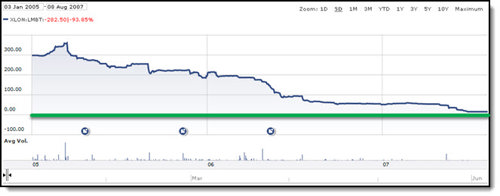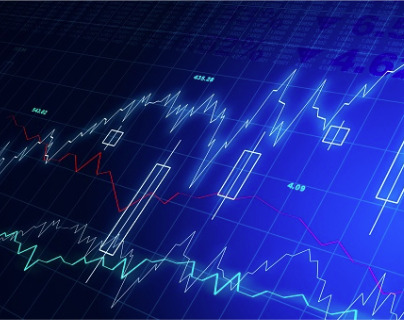Let me ask you what was your best investment?
What about your worse investment?
Loss is burned in my mind
For the life of me I cannot remember my best investment. I can however easily tell you what my worst investment was even though it happened over 17 years ago!
This article is about exactly that, my worse investment and how you can avoid the same happening to you.
Here is the story.
Very undervalued company
In March 2006 I came across a very undervalued small company in the UK on a screen I use to find cheap investment ideas.
This is how cheap it was:
- It had no debt
- Cash was equal to 8% of market value
- It was trading at book value.
- Price to earnings ratio was 6.5 (excl. goodwill written off)
- Looking at the average of the last seven years the company was trading on a price to earnings ratio of 5.6 and 7.0 times free cash flow.
- It had a market value of GBP34 million and in 2005 bought back shares with a value of GBP10.2 million, 30%! - and
- Based on the previous year’s dividend it had a 6.5% yield.
You must admit it was cheap!
The first buy
The company was the Lambert Howarth Group PLC (Lambert Howarth) and it designed, sourced, and supplied footwear, accessories and houseware products under its own labels and licensed brands to retail customers.
On 26 April 2006 I bought my first shares at GBP1.69, the day after the 2005 results were released.
Two weeks later the share price was 11.4% lower after management said trading was disappointing and below expectations. I bought a few more shares at GBP1.495.
Price falling – I kept on buying
Over the next month the share price kept on falling and I kept on buying – this is something I now NEVER do more than once.
A month and a half after my first purchase the share price was down 44% and I bought five times.
Shortly thereafter a good value investment fund Intrinsic Value Investors bought a 4,9% stake in the company. I thought I could not be completely wrong with my analysis.
I of course did not buy more without any analysis. Each time before I put in an order I re-looked my analysis, searched the internet for articles, called friends in the UK and asked them to look at the stores.
On 19 July 2006 the company announced the retail market had not improved since its last announcement and that sales in the first half of the financial year were significantly lower than expected. On the assumption that conditions will not recover in the second half, the company now expected that it will report a loss for the current financial year.
Analysis looks okay
Apart from the bad trading results I could not find anything else wrong with my analysis. Despite me looking at the company from every possible point of view. Tough retail conditions were affecting a lot of companies in the UK and were not a problem only Lambert Howarth had.
Unbelievable valuation
The company has reached the unbelievable valuation level of:
- Price to earnings ratio of 3.7
- 50% of book value
- Dividend yield of 14.7%
At the end of July 2006, thinking I was missing something serious; I asked a trusted friend (an excellent value investor) to look at the company.
He said that despite a sales decline the company was in good financial shape but that a lot will depend on the experienced new CEO. He saw it as a high-risk high reward investment with the risk lowered by the sound financial position of the company.
I continued to hold - and it kept falling
I continued to hold, and the stock price kept on dropping. By the end of August 2006, it declined over 60% from the price I first paid, four months ago.
At the end of August, I bought the last time.
At this time the share price was GBP0.6525 and the company was trading at a historical price to earnings ratio of 2.5 times, price to book ratio of 0.4 and a 16.9% historical dividend yield.
12% of my portfolio
At this time Lambert Howarth made up 12% of my portfolio valued at my purchase price and 6% in terms of the current price. Still a large position despite the 50% fall in price.
On 28 September 2006 the company as expected reported a loss for the half year ending June 2006 after writing off a lot of goodwill. What contributed to the loss what that fact that Marks & Spencer (their largest customer) started buying half of the shoes they normally bought through the company directly.
This was a very important fact I overlooked, but more on that later.
Insiders bought
On 30 October 2006 the non-executive Chairman of Lambert Howarth Group, bought 50 000 shares with a value of GBP29,937. He was not betting the house, but fair amount. A positive sign I thought.
In March 2007 the company announced that the restructuring, announced in September 2006, was well underway. This resulted in a few significant changes including that a new finance director was to be appointed.
Even though they said that trading in the first two months were difficult the company said that they were confident that the healthy first half order book will be converted into profitable sales over coming months, making up much of this shortfall.
Review strategic options – Major warning sign
The announcement also said that Pricewaterhouse Coopers has been appointed to act as its financial adviser as the board wanted to review its strategic options, and these may involve the raising of new equity. This was another important fact I also did not pay enough attention to.
On 1 May 2007 the company reported a loss before tax of GBP16.3m after goodwill and restructuring costs of GBP6.2 million. Sales decreased 29%, mainly because of the loss of half of the Marks & Spencer business mentioned above.
Not all doom & gloom
But it was not all doom and gloom with the chairman saying trading conditions began to improve towards the end of the year, a trend which has continued into the current financial year. He also said that the company was continuing its restructuring process, lowering costs, and moving more manufacturing to Asia.
But because of the poor performance of the business in 2006 and restructuring that it needs more capital. Adding that in the absence of such a fundraising it may not be able to operate within its existing bank facilities. This was the third and most important warning sigh I did not pay enough attention to.
Positive was that the company obtained licences from Radley, for the supply of ladies’ footwear and Pringle, for the supply of both men’s and ladies leather accessories.
Loss of 56%
At this stage the share price was GBP0.51 and the loss on my investment was 56%.
Thinking about it I cannot say what made me hold the investment despite the deterioration of the business.
I am sure I was overoptimistic, giving more weight to the vague positive statements of management.
Did not take the loss
Most important I simply did not want to take the loss. As you know realising a loss is a painful experience but a loss of 56% on a position that (at purchase) was 12% of your portfolio is bad.
Looking back this is the point where I should have finally cut my losses, but I didn’t.
Cut the long and painful story short
On 26 July 2007 the company said, due to unforeseen circumstances, it could no longer proceed with its proposed fundraising. It later turned out that the unforeseen circumstances were that Marks & Spencer was thinking of moving its shoe buying away from Lambert Howarth (the remaining 50%).
On 13 September 2007 Marks & Spencer said that they will stop all further orders with Lambert Howarth. This led to the company on 3 October 2007, due to the uncertainty over future levels of business and the cancellation of the fundraising, saying it was unable to publish its annual report and accounts for the year ended 31 December 2006.
Complete loss
And the board thus decided in the best interests of the creditors of the company for an administrator to be appointed.
The investment was a complete loss!
Here is the chart

Lambert Howarth share price graph
Source: Morningstar.co.uk
It was not a complete loss as the experience taught me a lot. And because of the large amount I have not forgotten a thing.
How you can avoid mistakes like this:
1. Management is always too optimistic.
If you cannot see it in the numbers, be sceptical. Think of management as salesmen trying to sell you something. They are not on your side!
2. Be very careful before you increase your investment if the price keeps dropping.
I now as a rule only buy once if a position declines, after a very thorough second analysis.
3. Be especially careful about investing more if the business is deteriorating.
I kept on buying as the company went from being undervalued to being extremely cheap (PE of 2.5) but that was all on historical earnings.
Make sure that past profitability can be achieved again before increasing your position. Think of what happened to Kodak and Nokia.
4. Think and plan what you will do if an investment loses money
After this experience I seriously started looking at trailing stop loss strategies and later adopted a STRICT 20% trailing stop loss.
You can read about all my research here: Truths about stop-losses that nobody wants to believe
The idea of limiting all your losses to 20% and making your winners run is attractive. Selling at a 20% loss is a good rule to set because if you give yourself too much freedom you will very likely never sell as it is painful to take a loss.


